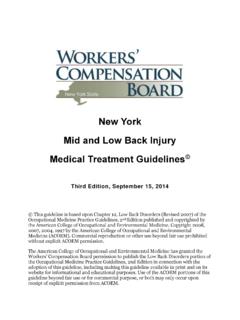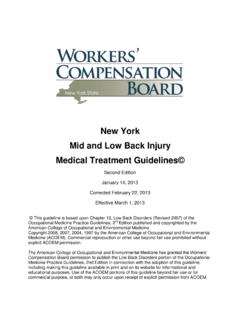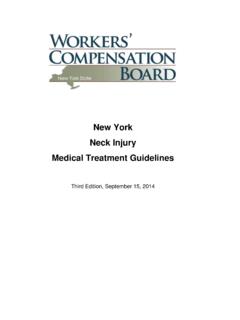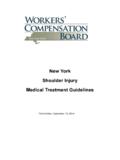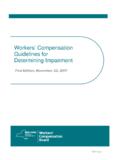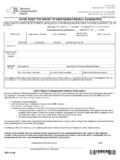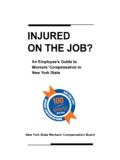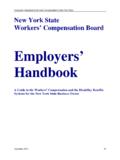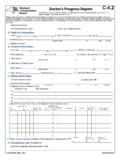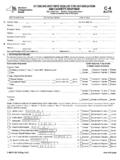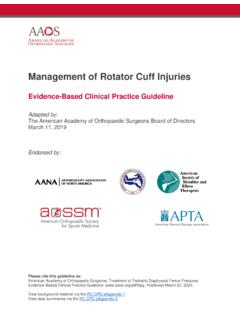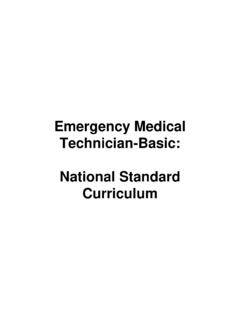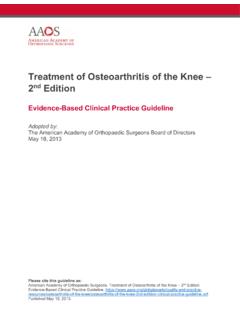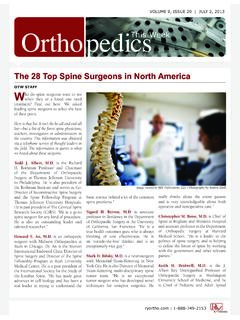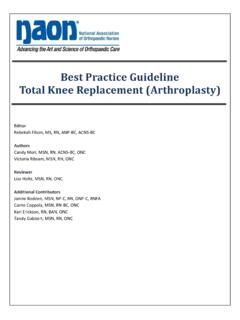Transcription of Medical Treatment Guidelines
1 MedicalTreatmentGuidelinesMid and Low Back InjuryEffective date will coincide with launch of OnBoard: Limited ReleaseAdapted by NYS Workers Compensation board ( WCB ) from MDGuidelines with permission of Reed Group, Ltd. ( ReedGroup ), which is not responsible for WCB s modifications. MDGuidelines are Copyright 2019 Reed Group, Ltd. All Rights Reserved. No part of this publication may be reproduced, displayed, disseminated, modified, or incorporated in any form without prior written permission from ReedGroup and WCB. Notwithstanding the foregoing, this publication may be viewed and printed solely for internal use as a reference, including to assist in compliance with WCL Sec. 13-0 and 12 NYCRR Part 44[0], provided that (i) users shall not sell or distribute, display, or otherwise provide such copies to others or otherwise commercially exploit the material. Commercial licenses, which provide access to the online text-searchable version of MDGuidelines , are available from ReedGroup at The NYS Workers Compensation board would like to thank the members of the New York Workers Compensation board Medical Advisory Committee (MAC).
2 The MAC served as the board s advisory body to adapt the american College of Occupational and Environmental Medicine (ACOEM) Practice Guidelines to a New York version of the Medical Treatment Guidelines (MTG). In this capacity, the MAC provided valuable input and made recommendations to help guide the final version of these Guidelines . With full consensus reached on many topics, and a careful review of any dissenting opinions on others, the board established the final product. New York State Workers Compensation board Medical Advisory Committee Joseph Canovas, Esq. Special Counsel New York State AFL-CIO Kenneth B. Chapman, MD Director Pain Medicine, SIUH Northwell Health Systems Assistant Clinical Professor, NYU Langone Medical Center Adjunct Assistant Professor, Hofstra Medical School Robert Goldberg, DO Attending Physician, Department of Rehabilitation, Beth Israel Hospital and Medical Center of NYC Professor of Physical Medicine and Rehabilitation and Health Policy Clinical Associate Professor of Rehabilitation Medicine, New York Medical College Clinical Professor of Rehabilitation Medicine, Philadelphia College of Osteopathic Medicine Member Council on Medical Education of the american Medical Association Brian M.
3 Gordon, MD Former Medical Director, New York State Workers Compensation board Frank Kerbein, SPHR Director, Center for Human Resources The Business Council of New York State, Inc. Joseph Pachman, MD, PhD, MBA, MPH Licensed Psychologist and Physician board Certified in Occupational Medicine Fellow in ACOEM Vice President and National Medical Director, Liberty Mutual James A. Tacci, MD, JD, MPH Medical Director and Executive Medical Policy Director, New York State Workers Compensation board Edward C. Tanner, MD Chair, Department of Orthopaedics at Rochester General Hospital Past President, New York State Society of orthopaedic surgeons (NYSSOS) Member, american academy of orthopaedic surgeons (AAOS) Member, american Association of Hip and Knee surgeons (AAHKS) This guideline is based upon Chapter 12, Low Back Disorders (Revised 2007) of the Occupational Medicine Practice Guidelines , 2nd Edition published and copyrighted by the american College of Occupational and Environmental Medicine.
4 Copyright 2008, 2007, 2004, 1997 by the american College of Occupational and Environmental Medicine (ACOEM). Commercial reproduction or other use beyond fair use prohibited without explicit ACOEM permission. The american College of Occupational and Environmental Medicine has granted the Workers Compensation board permission to publish the Low Back Disorders portion of the Occupational Medicine Practice Guidelines , 2nd Edition in connection with the adoption of this guideline, including making this guideline available in print and on its website for informational and educational purposes. Use of the ACOEM portions of this guideline beyond fair use or for commercial purpose, or both may only occur upon receipt of explicit permission from ACOEM. Revised July 2021 NYS WCB MTG - Mid and Low Back Injury 1 Table of Contents A. General Guideline Principles .. 3 Medical Care .. 3 Rendering Of Medical 3 Positive Patient Response.
5 3 Re-Evaluate 3 Education .. 3 Acuity .. 4 Initial 4 Diagnostic Time 4 Treatment Time Frames .. 4 Delayed Recovery .. 4 Active Interventions .. 5 Active Therapeutic Exercise Program .. 5 Diagnostic Imaging And Testing Procedures .. 5 Surgical Interventions .. 6 Pre-Authorization .. 6 Psychological/Psychiatric Evaluations .. 6 Personality/Psychological/Psychosocial Intervention .. 7 Functional Capacity Evaluation (FCE) .. 7 Return To 8 Job Site 8 Guideline Recommendations And Medical Evidence .. 9 Experimental/Investigational Treatment .. 9 Injured Workers As Patients .. 9 Scope Of 9 B. Introduction to Mid and Lower Back Injury .. 10 History Taking and Physical Examination .. 10 Imaging / Anatomical 13 NYS WCB MTG - Mid and Low Back Injury 2 Laboratory 14 Follow-Up Diagnostic Imaging and Testing Procedures .. 14 C. Diagnostic Studies.
6 15 Imaging Studies .. 15 Other Tests / Procedures .. 20 D. Therapeutic Procedures: Non-Operative .. 21 Acupuncture .. 22 Appliances .. 23 Bed Rest .. 23 Biofeedback .. 24 Electrical 24 Injections: Therapeutic Spinal .. 26 36 43 Therapy Ongoing Maintenance Care .. 51 Radiofrequency Ablation, Neurotomy, Facet Rhizotomy .. 52 E. Therapeutic Procedures: Operative .. 54 Discectomy, Microdiscectomy, Suquestrectomy, Endoscopic Decompression 54 55 Decompressive Surgery (Laminotomy / Facetectomy Laminectomy .. 55 Spinal 55 Electrical Bone Growth Stimulators .. 56 Disc Replacement .. 57 Vertebroplasty and Kyphoplasty .. 58 Sacroiliac Surgery .. 58 Intraoperative Monitoring / Image Guidance / Robotic Surgery .. 60 Implantable Spinal cord Stimulators (SCS) .. 60 NYS WCB MTG - Mid and Low Back Injury 3 A. General Guideline Principles The principles summarized in this section are key to the intended application of the New York State Medical Treatment Guidelines (MTG) and are applicable to all Workers Compensation Medical Treatment Guidelines .)
7 Medical Care Medical care and Treatment required as a result of a work-related injury should be focused on restoring functional ability required to meet the patient s daily and work activities with a focus on a return to work, while striving to restore the patient s health to its pre-injury status in so far as is feasible. Rendering Of Medical Services Any Medical provider rendering services to a workers compensation patient must utilize the Treatment Guidelines as provided for with respect to all work-related injuries and/or illnesses. Positive Patient Response Positive results are defined primarily as functional gains which can be objectively measured. Objective functional gains include, but are not limited to, positional tolerances, range of motion, strength, endurance, activities of daily living (ADL), cognition, psychological behavior, and efficiency/velocity measures which can be quantified.
8 Subjective reports of pain and function may be considered and given relative weight when the pain has anatomic and physiologic correlation in proportion to the injury. Re-Evaluate Treatment If a given Treatment or modality is not producing positive results within a well-defined timeframe, the provider should either modify or discontinue the Treatment regime. The provider should evaluate the efficacy of the Treatment or modality 2 to 3 weeks after the initial visit and 3 to 4 weeks thereafter. These timeframes may be slightly longer in the context of conditions that are inherently mental health issues, and shorter for other non-musculoskeletal Medical conditions ( pulmonary, dermatologic etc.). Recognition that Treatment failure is at times attributable to an incorrect diagnosis a failure to respond should prompt the clinician to reconsider the diagnosis in the event of an unexpected poor response to an otherwise rational intervention.
9 Education Education of the patient and family, as well as the employer, insurer, policy makers and the community should be a primary emphasis in the Treatment of work-related injury or illness. Practitioners should develop and implement effective educational strategies and skills. An education-based paradigm should always start with communication providing reassuring information to the patient. No Treatment plan is complete without addressing issues of individual and/or group patient education as a means of facilitating self-management of symptoms and prevention of future injury. NYS WCB MTG - Mid and Low Back Injury 4 Time Frames Acuity Acute, Subacute and Chronic are generally defined as timeframes for disease stages: Acute Less than one month Subacute - One to three month, and Chronic - greater than three months. Initial Evaluation Initial evaluation refers to the acute timeframe following an injury and is not used to define when a given physician first evaluates an injured worker (initial encounter) in an office or clinical setting.
10 Diagnostic Time Frames Diagnostic time frames for conducting diagnostic testing commence on the date of injury. Clinical judgment may substantiate the need to accelerate or decelerate the time frames discussed in this document. Treatment Time Frames Treatment time frames for specific interventions commence once treatments have been initiated, not on the date of injury. It is recognized that Treatment duration may be impacted by disease process and severity, patient compliance, as well as availability of services. Clinical judgment may substantiate the need to accelerate or decelerate the time frames discussed in this document. Delayed Recovery For those patients who fail to make expected progress 6-12 weeks after an injury and whose subjective symptoms do not correlate with objective signs and tests, reexamination in order to confirm the accuracy of the diagnosis and re-evaluation of the Treatment program should be performed.
